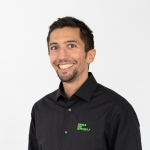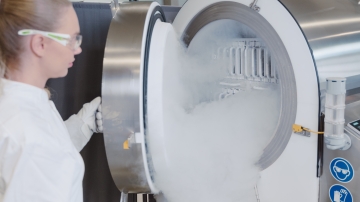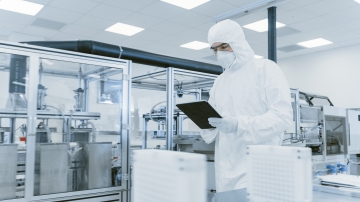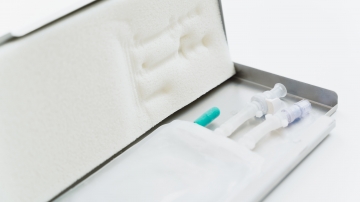Safety & Speed: handling two major factors in CAR T-cell therapy
Table of contents
Show
CAR T-cell therapy is a promising approach in cancer treatment. The therapy shows huge potential for patients suffering from acute lymphoblastic leukemia who thus far had a poor prognosis: Thanks to the emergence of CAR T-cell therapy, the 5-year survival rate of 10% to 20% has improved remarkably, promising a high complete remission (CR) rate of 57% to 93%.1
Those numbers speak for themselves. So it’s no surprise that an ever-growing number of novel agents with CAR designs and targets is being produced - despite the high costs and elaborate processes involved.
Costs and elaborate processes, however, are just two of the challenges experienced by researchers and manufacturers. As is the case with any new (and, incidentally, established) developments, autologous therapies come with their own set of challenges and limitations, most notably speed and safety.
CAR T-cell therapy: Exclusive treatment with high potential
Based on the concept of using the immune system to fight cancer, CAR T-cell therapies have the potential to revolutionize cancer treatment and therapy. And while there are a handful of FDA-approved therapies available and several hundred more currently being investigated, their use and application is still limited. As of now, despite its high potential, it is a highly exclusive approach, not least due to the costs involved.
Challenges in the commercialization of CAR T-cell therapy
While high costs are a definite challenge in making CAR T-cell therapy widely available, there are other hurdles to overcome in order to exhaust the full potential of this type of therapy. CAR T-cell therapies are personalized and autologous, using the patient’s own, genetically modified, T-cells to fight the cancer cells. This requires a complex and elaborate manufacturing process, which, along with the supply and cooling chain, adds to the challenges.
Safety & speed as two main issues
The extraction, manipulation and re-infusion of small batches of autologous cells is complex and costly. Manufacturing is largely centralized, with a shortage of manufacturing slots for either the CAR T cell or requisite viral vector proving to be one of the key bottlenecks.
In addition, shipping the cells between manufacturing facilities and hospitals calls for an elaborate and complex, uninterrupted cold chain. When it comes to saving a patient’s life, speed and safety are key - as is the safe handling of the matter, where special protective and coolable packaging play a crucial role.
What does it take to cure more people with CAR T-cell therapy?
In order for CAR T-cell therapies to become less exclusive, there is the need for an “off-the-shelf” variant that is both available on demand and less costly than the current therapies available.
However, thus far, CAR T-cells, being a completely new type of therapy, fall between several regulatory frameworks, which can vary from country to country. But with the first therapies already on the market, the way is open for further development and improved products.
One big goal for the future is the development of an allogeneic CAR T-cell therapy, which means that T cells can be sourced from a healthy donor instead of the patient, making them ready to go on demand as opposed to engineering each patient’s T cells individually. This would be a major step, saving precious time for patients who currently have to wait for about two weeks for their engineered cells to become available to them.
Just recently, Novartis has announced the implementation of a next-generation platform that aims to revolutionize CAR T-cell therapy. The T-Charge platform preserves T cell stemness, the ability to self-renew and mature.2
This is great news, however, as with all of the developments mentioned above, it will only be feasible provided there is a functioning and speedy, standardized cooling and supply chain in place.
Handling safety & speed with small volume end-to-end solutions
The process involved in manufacturing and applying CAR T-cell therapies is a complicated one, involving the collection of the patient’s white blood cells and manipulating them in the lab before reintroducing them to the patient’s system by means of infusion.

In order to allow for a smooth and functioning process, a reliable supply chain, tailored to the specific needs of autologous therapies, is a prerequisite. Any of the established systems, however, are usually designed for vast amounts of drug substance. This is why Single Use Support has developed an end-to-end process solution for cell and gene therapies, and able to handle as little as 0.03 to 0.2 fl oz (1 to 10mL).
The system neither requires complicated adaptations nor extensions that might prove difficult to implement in a sterile setting and when time is of the essence. Quite on the contrary, the platform is easy to adapt and allows for a controlled and monitoring end-to-end process. Another important step in being able to offer the therapy to many people quickly and safely.
1.
Xu X, Huang S, Xiao X, et al. Challenges and Clinical Strategies of CAR T-Cell Therapy for Acute Lymphoblastic Leukemia: Overview and Developments. Front Immunol. Published online February 10, 2021. doi:10.3389/fimmu.2020.569117
2.
Novartis MR. Novartis announces T-ChargeTM, next-generation CAR-T platform with first-in-human data at ASH 2021. NOVARTIS News. December 13, 2021:1.









